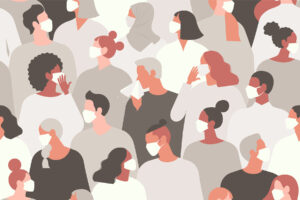COVID-19: The Pandemic and Public Health in Crisis
By Kenna Caprio
In the fight against COVID-19, these are the best weapons: a functioning public-health system; focused public-health education; and shared resources, including accurate data.
Michael Avaltroni, dean of the School of Pharmacy and Health Sciences, and Bojana Berić-Stojšić, program director of the Master of Public Health and associate professor of public health, break down what’s next, as the pandemic continues.
“Viruses become endemic; they do not disappear,” says Berić-Stojšić. “It’s about controlling and arresting the spread. I don’t think there will be a vaccine widely available before next spring.”

Why is investing in public health critical to curbing COVID-19 and to offering future protections?
Avaltroni: We need to invest in moving public health front and center — it should underpin much of the decision-making in health care.
Berić-Stojšić: It means redefining and redesigning public-health practice — we need one system that provides infrastructure for both preventative and traditional “health care” intervention services. We talk about public health as a system, but it’s not one in our country. Sectors need to be in sync to curb COVID-19.
We need to invest in the education and preparation of the public-health workforce, including community health workers, contract tracers and other professionals at local, state and federal levels.
What should public health education include?
Avaltroni: We have a population that struggles with health literacy and in interpreting scientific finding and understanding. People need to understand basic data and evaluation of data to understand the arguments being made.
Berić-Stojšić: Health literacy and numeracy — the ability to understand and interpret data and to know where your community is on the curve — is important in navigating and in helping curb the spread. The reality is that the virus is still in our communities.
One of the premises of public health is social justice. We want to redesign curriculum starting in kindergarten up through college and postgraduate school — with health as a human right and education as a human right. These are rights, not privileges.
Avaltroni: The same social-justice issues that pervade the criminal-justice system also pervade health care. From cradle to grave there are issues that affect disproportionate portions of the population — the economically disadvantaged and underrepresented minority groups. These are complex, deep-rooted problems that don’t have simple solutions.

(Photo: iStock)
How do we share data, and encourage states and nations to collaborate more in this interconnected world?
Avaltroni: A public-health shortfall is that we have 50 states in the U.S., with 50 unique metrics on reporting. There is no consistency. The Centers for Disease Control and Prevention (CDC) and other agencies have been stripped of resources. Much of the state-by-state decision-making has been inconsistent, in terms of preventative measures and data reporting.
Berić-Stojšić: In past years, doctor’s offices would report to local health departments, and that reporting went to a state’s department of health, then to the CDC to be compiled, analyzed and summarized into public reports. But this administration is neglecting the work of the CDC. In any emergency, there needs to be a central, reliable and credible source of information.
Public health organizations, such as the World Health Organization and the CDC, are part of the global society. A core value at FDU is teaching students to become global citizens — resilient, caring and optimistic individuals.
Avaltroni: Individualism is an important point of American culture. But we need to care enough to be good neighbors. We can find balance and in so doing, make decisions that benefit the individual and the collective.
Berić-Stojšić: Other societies and nations are more collectivistic. We need to build that sense of care.
Avaltroni: It’s a cultural shift.
Where do we go from here?
Avaltroni: Disease transmission doesn’t occur through the air without people around. Lack of fundamental understanding allows people to make bad decisions with collateral damage — psychological, social and economic impact. You have to create measurable, manageable expectations, a healthy dose of caution without fear.
The practice of public health is where we make an impact — in understanding the reasons and science behind things we’re told to do, such as wear masks, wash hands and social distance. Be responsible and be cautious for yourself and for others.